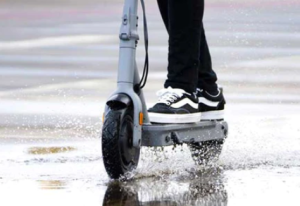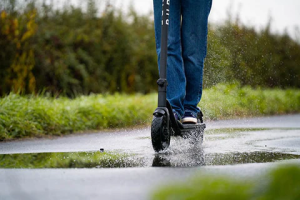Protect your electric scooter from rain by using waterproof covers, sealing components, and performing regular maintenance and post-rain inspections
Preventive Measures Before Rainy Season
Protecting your electric scooter from rain starts well before the first drops fall. Preparing in advance ensures your scooter remains safe and functional throughout wet conditions.
Waterproofing Critical Components
- Seal Joints and Openings: Use silicone-based sealants to cover any gaps where water might enter, especially around the battery compartment and control panels. This prevents water from reaching sensitive electrical parts.
- Protective Coatings for Electrical Parts: Apply a waterproof coating, such as a corrosion-inhibitor, to exposed metal parts. Products like WD-40 Specialist Long-Term Corrosion Inhibitor provide a protective layer against moisture, extending the lifespan of these components.
- Upgrade to Waterproof Accessories: Consider replacing standard parts with waterproof variants. For instance, installing a waterproof LCD display or control buttons can drastically reduce the risk of water damage.
- Battery Protection: Ensure the battery compartment is fully sealed. Some scooters come with IP ratings that indicate their level of water resistance. For added protection, consider a waterproof battery case.
Regular Maintenance Checks
- Brakes and Tires Inspection: Regularly check the brakes and tires for wear and tear. Wet conditions can reduce braking efficiency, so it’s crucial to ensure these parts are in top condition. Tires with good tread provide better grip on wet surfaces, enhancing safety.
- Battery Health: Regularly monitor the battery’s performance. Exposure to water can affect battery life and efficiency. If you notice any decrease in power or efficiency, inspect the battery for any signs of water ingress.
- Lubrication of Moving Parts: Keep moving parts well-lubricated with a water-resistant lubricant. This not only prevents rust but also ensures that parts like the suspension and folding mechanisms operate smoothly.
- Check Electrical Connections: Inspect all electrical connections for signs of corrosion or water damage. Clean and tighten connections as necessary to ensure optimal performance.
Effective Rain Covers and Accessories
When it comes to safeguarding your electric scooter from rain, selecting the right cover and accessories is crucial. These protective measures not only enhance the longevity of your scooter but also ensure its readiness for use, regardless of the weather conditions.
Choosing the Right Scooter Cover
A scooter cover is the first line of defense against rain. Selecting a cover that fits your scooter’s dimensions is essential. Scooter covers come in various sizes, and a snug fit prevents water from pooling and seeping into sensitive areas. Materials matter significantly; high-quality, waterproof fabrics like polyester or nylon offer robust protection. These materials are not only water-resistant but also provide UV protection, which is a bonus for maintaining the scooter’s appearance.
When evaluating scooter covers, consider the ease of use and storage. A cover that is cumbersome to put on or remove might discourage regular use. Look for options with elastic hems and straps that provide a secure fit and are easy to handle. Additionally, a cover that folds into a compact form facilitates convenient storage when not in use.
Cost is another factor to consider. While it’s tempting to go for the cheapest option, investing in a quality cover pays off in the long run. Prices typically range from $20 to $50, depending on the material quality and additional features like lock holes or reflective strips for visibility.
Essential Waterproof Accessories
Beyond the scooter cover, several waterproof accessories can significantly enhance your scooter’s rain protection.
Waterproof bags and cases are a must for anyone who carries gadgets or important documents. These bags come in various sizes and can attach to different parts of the scooter, providing easy access while protecting your belongings.
Water-resistant control panel covers safeguard the scooter’s electronic interface. A wet control panel can lead to malfunctions or permanent damage. These covers are usually transparent, allowing for easy visibility and use of the controls.
Protective sprays and coatings offer an additional layer of protection for the scooter’s body and mechanical parts. Products like silicone sprays or corrosion inhibitors help repel water and prevent rust. They are affordable, with prices usually under $20, and easy to apply.
During the Rain: Best Practices for Scooter Users
Riding an electric scooter in the rain requires additional precautions to ensure safety and maintain the scooter’s condition. Adapting to wet conditions and providing immediate post-ride care are essential steps.
Safe Riding Techniques in Wet Conditions
Adjusting Your Speed is crucial. Wet surfaces significantly reduce your scooter’s traction, increasing the risk of accidents. It’s advisable to reduce your normal riding speed by at least 30-40% in rainy conditions. This reduction gives you more time to react to unexpected situations, such as slippery surfaces or sudden obstacles.
Avoiding Puddles and Standing Water can’t be overstressed. Puddles can conceal potholes, debris, or be deeper than they appear, posing a risk to both your safety and the scooter’s electrical components. Water ingress can damage parts like the motor and battery, leading to costly repairs.
Braking Carefully becomes more important in the rain. The stopping distance on wet surfaces increases. Therefore, apply the brakes gently and progressively to avoid skidding. If your scooter has anti-lock brakes (ABS), it’s a significant advantage in maintaining control during braking.
Using Proper Lighting and Reflective Gear enhances visibility, a key factor in rainy conditions. Ensure your scooter’s lights are functioning correctly and consider wearing reflective clothing or accessories. This practice not only helps you see better but also makes you more visible to others.
Immediate Post-Ride Care
Drying Your Scooter Thoroughly immediately after a ride prevents water damage. Focus on drying the electrical components, such as the battery and motor. Using a dry cloth to wipe down the scooter is usually sufficient. Avoid direct heat sources, as they can damage certain materials.
Checking for Water Ingress in areas like the battery compartment, control panel, and charging ports is essential. Water in these areas can lead to short circuits or corrosion. If you find any moisture, dry it immediately and, if necessary, consult a professional for further inspection.
Lubricating Moving Parts after a wet ride helps prevent rust and ensures smooth operation. Apply a water-displacing lubricant to parts like the chain, bearings, and joints. Be cautious with the amount of lubricant used, as excess can attract dirt and grime.
Storage Solutions for Electric Scooters
Proper storage of electric scooters, whether indoors or outdoors, is key to ensuring their longevity and maintaining their condition. Different environments call for specific storage strategies to protect your scooter from elements like weather, theft, or damage.
Indoor Storage Tips
Selecting the Right Space: Opt for a dry, well-ventilated area to store your scooter. This could be a garage, shed, or a dedicated space in your home. The ideal storage temperature ranges between 10°C and 25°C to preserve battery health.
Using a Scooter Stand or Wall Mount: Storing the scooter upright using a stand or a wall mount saves space and keeps the scooter off the ground, which is beneficial for tire longevity. Wall mounts are available in various designs and typically cost between $15 and $30.
Battery Care During Storage: If you plan not to use the scooter for an extended period, charge the battery to about 50-60% before storage. This level is optimal for preserving battery life. Check and recharge the battery every 30 days to maintain its health.
Avoid Storing Near Heat Sources: Keep the scooter away from direct heat sources like radiators or sunny windows. Excessive heat can degrade the battery and other components over time.
Protecting Your Scooter in Outdoor Environments
Investing in a Quality Cover: If indoor storage isn’t an option, a high-quality waterproof and UV-resistant cover is essential. Ensure the cover has a secure fit to protect against weather elements and dust.
Securing the Scooter Against Theft: Use a robust lock when storing the scooter outside. U-locks or chain locks offer good security and typically range from $20 to $50, depending on their quality and brand.
Elevating the Scooter from Direct Ground Contact: If possible, place the scooter on a raised platform or overhang to avoid direct contact with ground moisture or puddles, which can cause rust and corrosion.
Regular Maintenance Checks: When storing outdoors, perform more frequent maintenance checks for signs of weather-related wear or potential tampering.
Repair and Maintenance Post-Rain Exposure
After your electric scooter has been exposed to rain, it’s imperative to conduct thorough checks and maintenance to ensure its longevity and optimal performance. Addressing any water damage promptly and adhering to long-term maintenance routines are essential.
Identifying and Addressing Water Damage
Inspecting Electrical Components: Check the battery, motor, and control panel for any signs of water ingress. Signs like rust, corrosion, or malfunctioning lights and displays indicate water damage. If the battery shows any signs of swelling or leakage, replace it immediately, as this can lead to serious safety hazards.
Examining Mechanical Parts: Look for rust or corrosion on metal parts like the chain, bearings, and screws. Apply a rust remover or corrosion inhibitor if you find any rust. Products like WD-40 can be effective and typically cost around $5 to $10.
Testing the Scooter’s Functionality: After ensuring all parts are dry, test the scooter’s brakes, acceleration, and balance to ensure they are working correctly. If you notice any irregularities, it may be necessary to consult a professional repair service.
Long-Term Maintenance for Rain-Exposed Scooters
Regular Lubrication: Moving parts like chains and bearings should be lubricated regularly to prevent rust and ensure smooth operation. Use a water-resistant lubricant, and perform this maintenance every few weeks or after exposure to rain.
Battery Care: Keep the battery charged and avoid storing the scooter with a depleted battery. A lithium-ion battery’s lifespan is typically around 500-1000 charge cycles, and proper care can maximize its longevity.
Frequent Component Checks: Regularly inspect your scooter for any loose parts, wear and tear, or signs of water damage. Tightening loose screws and replacing worn parts can prevent further damage and maintain the scooter’s performance.
Storage Precautions: Store the scooter in a dry, cool place. If you frequently ride in rain, consider investing in a dehumidifier for your storage area to help keep the environment dry and protect the scooter from moisture.



